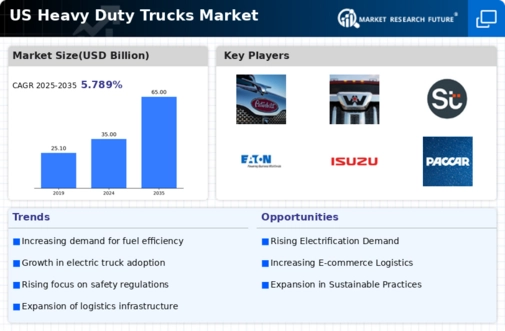Increasing Freight Demand
The heavy duty-trucks market is experiencing a notable surge in freight demand, driven by the expansion of e-commerce and logistics sectors. As businesses increasingly rely on efficient transportation to meet consumer needs, the demand for heavy duty trucks is projected to grow. In 2025, the freight transportation industry in the US is expected to reach approximately $1 trillion, with heavy duty trucks accounting for a substantial share of this market. This growth is likely to stimulate investments in truck manufacturing and innovation, thereby enhancing the overall competitiveness of the heavy duty-trucks market. Furthermore, the increasing need for timely deliveries and supply chain efficiency is propelling the adoption of advanced logistics solutions, which further supports the heavy duty-trucks market's expansion.
Regulatory Compliance and Standards
the market is significantly influenced by stringent regulatory compliance and standards imposed by government agencies.. These regulations, aimed at reducing emissions and enhancing safety, compel manufacturers to innovate and upgrade their fleets. For instance, the Environmental Protection Agency (EPA) has set ambitious targets for reducing greenhouse gas emissions from heavy duty vehicles. As a result, manufacturers are investing heavily in research and development to meet these standards, which could lead to the introduction of cleaner and more efficient trucks. Compliance with these regulations not only ensures market access but also enhances the reputation of companies within the heavy duty-trucks market, potentially leading to increased sales and market share.
Infrastructure Development Initiatives
Infrastructure development initiatives in the US are playing a crucial role in shaping the heavy duty-trucks market. The government has allocated substantial funding for the improvement of highways, bridges, and transportation networks, which directly benefits the trucking industry. In 2025, the US is expected to invest over $100 billion in infrastructure projects, enhancing the efficiency and safety of freight transportation. Improved infrastructure reduces transit times and operational costs for heavy duty trucks, making them more attractive to logistics companies. This investment in infrastructure not only supports the heavy duty-trucks market but also stimulates economic growth by facilitating smoother supply chain operations.
Rising Fuel Prices and Efficiency Demands
Rising fuel prices are exerting pressure on the heavy duty-trucks market, prompting companies to seek more fuel-efficient solutions. As fuel costs represent a significant portion of operational expenses, the demand for trucks with better fuel economy is increasing. In 2025, it is projected that fuel prices may rise by 10%, further incentivizing the adoption of advanced engine technologies and alternative fuels. This shift towards efficiency not only helps companies reduce costs but also aligns with broader sustainability goals. Consequently, the heavy duty-trucks market is likely to witness a growing emphasis on innovation aimed at enhancing fuel efficiency and reducing environmental impact.
Technological Integration in Fleet Management
The integration of advanced technologies in fleet management is transforming the heavy duty-trucks market. Companies are increasingly adopting telematics, GPS tracking, and data analytics to optimize their operations. These technologies enable real-time monitoring of vehicle performance, fuel efficiency, and driver behavior, leading to cost savings and improved safety. In 2025, it is estimated that the adoption of such technologies could reduce operational costs by up to 15% for trucking companies. This trend towards technological integration not only enhances the competitiveness of the heavy duty-trucks market but also attracts new entrants seeking to leverage these innovations for operational excellence.























Leave a Comment